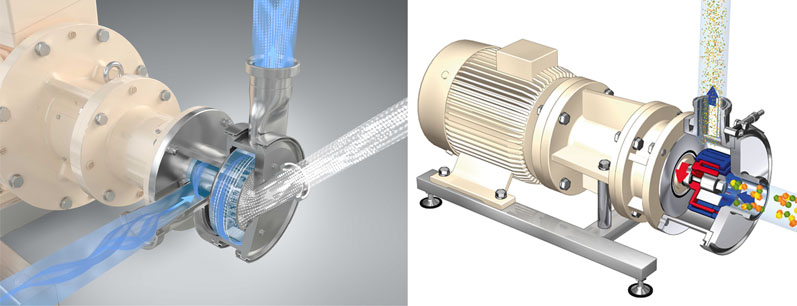Whether it’s a plant-based lactose-free alternative to milk, vegan ice cream or a meatless steak, animal-free foodstuffs are on the rise.
The most important components of these “new foods” are proteins; and although often plant-derived, processing these powdered ingredients can be difficult.
To ensure optimum product quality, the proteins must be unlocked, starches must be degraded to the required degree and agglomerates/foam must be avoided during production. All of this can be achieved with the vacuum expansion process.
A quick glance at the supermarket shelves shows the increasing presence of vegan foods as replacements for animal-based items such as burgers, sausages or milk products.
As an alternative to animal milk, for example, and in addition to oat, soy, rice, coconut or almond drinks, available options now also include varieties based on plants such as peas, lentils, adzuki or fava beans, cashews and peanuts.
Not to mention the growing number of vegan items such as whipping cream, yoghurts and spreads.
Although vegetable proteins have, as yet, been the most important ingredients of new food products, other protein types are expected to gain in importance soon.
This is particularly notable when it comes to fermented proteins: these are mainly obtained from bacteria or yeast, have a neutral taste, are inexpensive and cost-effective to produce.
Importantly, they are also easily digestible and contain — a crucial advantage compared with plant-based proteins — all the essential amino acids as well as vitamin B12, which is indispensable for the human organism.
Novel foods require new technologies
What the alternative proteins that are currently used in the new food segment have in common is that they are difficult to process. They also have very different characteristics: wheat protein for example, is extremely cohesive, whereas soy protein is very adhesive.
If protein powders derived from seeds, grains, nuts and pulses are mixed into water, they are prone to clogging, agglutinating and foaming. The proteins are both shear-sensitive and, counterintuitively, require high-shear processing to ensure dispersal (into a liquid). Therefore, rapid shearing under controlled conditions is essential.
To achieve optimum product quality, it’s important to ensure that any powder agglomerates are instantly and fully broken up when mixed into a liquid. Ideally, these clumps wouldn’t be formed at all. The use of time-consuming stirring steps to redisperse the particles can negatively affect both the process and the final product.
Dispersing the agglomerates damages the quaternary and tertiary structure of the hydrated protein and impairs both viscosity and texture.
Similarly, when it comes to any starch content, the prevention of agglomerates is also very important. Starch degradation, when required, is usually done using enzymes (and occasionally acids).

Dr-Ing. Hans-Joachim Jacob
If powder particles are already separated before the introduction of a liquid, and highly dispersed during powder induction, the enzymatic degradation of the starch is enhanced and accelerated.
With conventional agitators, injectors or inline blenders, powder particles are generally fed into the liquid component as a compact discharge. This leads to sturdy, partially wetted agglomerates that are difficult to break down.
Subsequent redispersion not only involves considerable amounts of time and energy, but the inherent air in the protein powder is also dispersed to form undesired microfoam froth.
When protein powder is fed into the liquid during conventional processing, it either flocculates or sticks to the (rotating) machine parts. This results in local overheating, discolouration or even burning, imbuing the end products with a slightly charred taste. A large proportion of the proteins that were not fully unlocked is filtered out and unused.
Powder particle separation with vacuum expansion
The problems associated with conventional process engineering solutions can be avoided by using vacuum expansion. With this method, the air contained in the powder is expanded, which significantly enlarges the distance between the particles.
The primary protein particles are, therefore, separated before they enter the liquid; they are fully wetted on first contact with the liquid, they are dispersed in situ under vacuum and subsequently hydrated — with no agglomerates — under pressure. The whole process takes 2–3 hundredths of a second with minimal heat input.
The powder dissolves immediately, no agglomerates are formed and the overall texture is neither damaged nor destroyed. The process time compared with conventional technologies is significantly reduced.
Because of this intense dispersion, significantly fewer enzymes are needed to degrade the starch compared with conventional procedures.
The air, which was previously contained in the powder, is separated from the heavier fraction because of the centrifugal effect of the fast-running rotor; these coalesce into large air bubbles, which can easily escape in the process vessel. Foam, which is often generated during protein processing, is almost completely prevented.
Versatile process options
Technology from ystral can be precisely tailored to the requirements of specific powder types. To process oatmeal, for example (same as for soy and rice), dispersal using vacuum expansion with an inline powder wetting and dispersing machine (such as the YSTRAL Conti-TDS) is sufficient.
Other powders containing protein (such as coconut or some pea flours) require additional dispersal under high-shear conditions to fully break down the product.
In these instances, a Z-Inline Disperser is recommended (in addition to the Conti-TDS), which redisperses the protein powder while the entire powder is introduced. The Z-Inline Disperser can be operated either in parallel in a separate circuit or in series.

The Conti-TDS (left) and Z-Inline Disperser (right)
With a special version of the YSTRAL Conti-TDS, strongly adhesive and powders that are especially prone to agglomeration can also be processed. Compared with other versions, no dispersing takes place at the time of wetting.
The powder is neither in contact with the rotor nor the stator … but is directly fed into the liquid flow at high speed. This method is called direct injection. The two input streams are monitored to prevent overly high concentrations of proteins being introduced too quickly.
This occurs using control valves for protein concentrates or combinations. Nozzles are used for isolates and pure proteins.
In addition, allergenic and non-allergenic powders can be accommodated and processed in separate liquid circuits.
A Conti-TDS can also be integrated into existing process systems and connected to several process vessels or storage tanks. The disperser can either be operated inline or in circuit on large process vessels; in addition, highly concentrated premixes can be created/used as a small batch and subsequently diluted in the main process vessels.
Better technology, better products
The choice of process equipment can significantly influence the taste, consistency, mouthfeel and visual impact of the final food product. To further improve the acceptance of vegan products in the public domain, it’s important that they don’t exhibit any negative attributes of this type when compared with traditional products.
To meet these demands, one promising technology is the use of vacuum expansion to optimise protein powder dispersion in new food applications.
